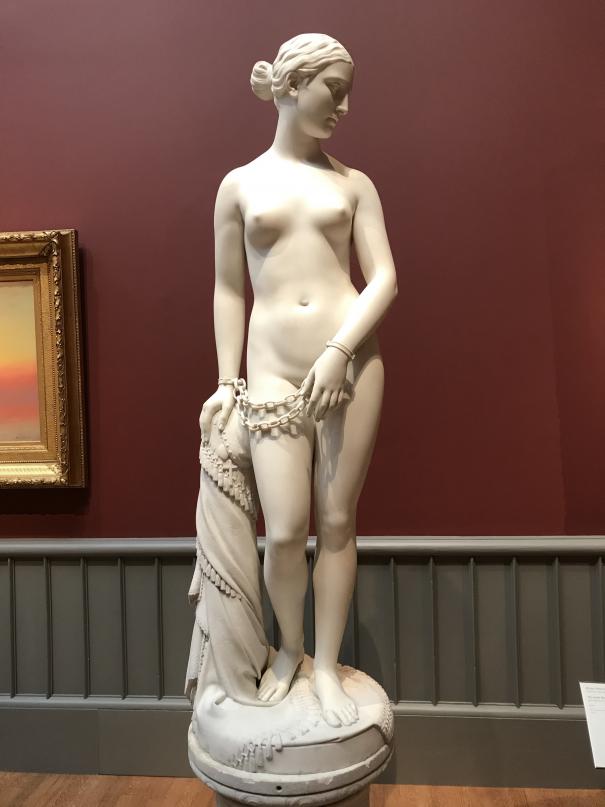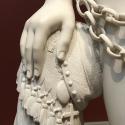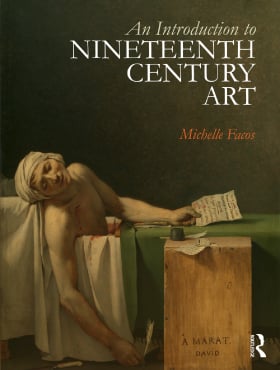Greek Slave
Documentation:
Powers explained his inspiration for The Greek Slave in a 14 December 1853 letter to his cousin John Richardson:
“When I was a child in Woodstock [Vermont] and for years afterwards in Ohio I was haunted in dreams with a white figure of a woman white as now from head to foot and standing upon some sort of pedestal below Uncle John’s house…At the time I knew nothing of sculpture…The dream ceased when I began to model – and you know that a white figure of a woman has since been seen in Woodstock [1850, when The Greek Slave was exhibited there] and answering in some respects at least to the vision of my childhood. I know not when I first conceived the idea of the ‘Greek Slave,’ I only know that it was on my mind long before I began it, just as you have seen it – and the dream occurs to me whenever I think of it….did the dream cease after I had taken the first steps as an artist because it was no longer necessary to stimulate me on the way I should go?”
Letter is in the Archives of American Art (1136/1095-6); cited in Charles Colbert, “Spiritual Currents and Manifest Destiny in the Art of Hiram Powers,” The Art Bulletin, vol. 82, no. 3 (September 2000): 535.
Years later, Powers offered another explanation:
“It was several years after being in this city [Florence, Italy], and while thinking about some new work to be commenced, that I remembered reading of an account of the atrocities committed by the Turks on the Greeks during the Greek Revolution…During the struggle the Turks took many prisoners, male and female, and among the latter were beautiful girls, who were sold in the slave markets of Turkey and Egypt. These were Christian women, and it is not difficult to imagine the distress and even despair of the sufferers while exposed to be sold to the highest bidder…”
1869 letter from Powers to Edwin W. Stoughton; cited in Linda Hyman, “The Greek Slave by Hiram Powers: High Art as Popular Culture,” Art Journal, vol. 35, no. 3 (Spring 1976): 216.
Vivian Green explains comments on then-contemporary writings about Powers’s Greek Slave :
“A pamphlet, published in 1848 to accompany the exhibition of the statue, offers further clarification of the reason for the figure’s nudity. Composed to illuminate the statue’s subject matter and iconography, the pamphlet explains that the innocent Christian transcends her physical enslavement and degradation through spiritual faith….”
“Examination of mid-century newspaper and journals suggests that public response to the statue was frequently associated not only with attitudes toward the Greek War of Independence, but with the increasingly abolitionist controversy in the United States as well.”
Vivian M. Green, “Hiram Powers’s Greek Slave: Emblem of Freedom,” American Art Journal, vol. 14, no. 4 (Autumn 1982): 32 & 34.
Descriptions of Powers’s Greek Slave evoke earlier descriptions of the classical (Hellenistic) Greek sculpture, the Medici Venus. Baron Dominique-Vivant Denon (1747-1825) became director of the Musée Napoleon in 1802. He described the Medici Venus:
"Dressed in her modesty alone, her nakedness is pure. Her expression of happiness belongs to her perfection, to the plenitude of her being. The smile on her face is not yet that of voluptuousness, and yet happiness is already on her lips."
Cited in Peter Brooks, "Napoleon's Eye," New York Review of Books (19 November 2009): 30-2.
A critic for the Eastport Sentinel considered Powers’s Greek Slave a painful reminder of the existence of slavery in the US:
“There is a painful significance…in the fact, that this masterpiece of our gifted American Artist should represent a youthful female slave. In no country could the truth and reality of the picture be better felt and understood. It brings home to us the foulest feature of our National Sin; and forces upon us the humiliating consciousness that the slave market at Constantinople is not the only place where beings whose purity is still undefiled, are basely bought and sold for the vilest purposes, -- and the still more humiliating fact that while the accursed system from which it springs has well nigh ceased in Mahomedan countries, it still taints a portion of our Christian soil, and is at this very moment clamoring that it may pollute yet more.”
Clipping from the Eastport Sentinel dated 23 August 1848, contained in Powers’s scrapbook; cited in Vivian M. Green, “Hiram Powers’s Greek Slave : Emblem of Freedom,” American Art Journal, vol. 14, no. 4 (Autumn 1982): 38 n. 40.
Donald Reynolds explains the complicated, if typical, process Powers used in producing various versions of The Greek Slave :
“The original plaster [of Greek Slave] for Powers’s first five replicas [is] covered with a dark satain, probably a shellac (although the stain has not been chemically analyzed), in order to render the plaster surface non-porous. The coating then acted as a mold-release, a preparatory step taken by a sculptor if he intended to make a cast from the model….Powers’s sixth (and last) Greek Slave (with manacles) now in The Brooklyn Museum was carved from a plaster model different from the original plaster from which the first five Slaves were carved….
What Powers modeled and carved, then, was in fact the original plaster. With his new method (which combined the additive and subtractive traditions of sculpture), he gained two distinct advantages – one, financial, the other, esthetic. The sculptor claimed that his invention reduced the time it took to produce a model by two-thirds, thus he realized an appreciable saving in time, and consequently money. More significant than the financial savings, however, was a unique esthetic advantage: the original plaster was Powers’s original conception. It came directly from his own hand, rather than from a mold that came from a clay model that came from his own hand….
In the normal process of making a statue in the nineteenth century from a clay model, unavoidable distortions occurred at each step. For example, when the mold was made from the clay model, shrinkage occurred, and then when the plaster model was cast from the mold, further alterations occurred that could not be anticipated with absolute accuracy. Thus, the original plaster model was something different from what the sculptor had created in clay.”
Donald M. Reynolds, “The ‘Unveiled Soul’: Hiram Powers’s Embodiment of the Ideal,” The Art Bulletin, vol. 59, no. 3 (September 1977): 408-9.
T. Walter Herbert comments on the challenge of interpreting Powers’s The Greek Slave :
“To the paradox in which desire is pursued and elicited by its denial is thus joined a paradox in which the absence of knowledge is a form of knowing, and yet this redoubling only begins to suggest the swarming multiplicity of oppositional psychic possibilities that the ethos of purity sponsored. Like the game of chess, the cultural logic at work here generated a seemingly inexhaustible dialectic of disparate potential realities that locked into place depending on how a given circumstance unfolded and on what became visible or desirable to whom….
The responses of Powers’s audience complicated this paradox of erotic solicitation and denial, as it dawned upon public commentators that the statue possessed overwhelming hypnotic power….This image of a woman’s sexual enslavement has a mysterious power to enslave; its ‘purity’ was so dominating that viewers reported falling into a religious rapture that could last for hours on end….
Yet the commanding power of the image is active in yet another paradox, since viewers who had paid the price of admission were implicitly placed in the role of purchasers at the slave market, an identification reinforced by their awareness that copies of the statue were available for purchase, ranging from inexpensive ceramics to full-sized versions from Powers’s own workshop….
The most striking of these paradoxical fusions may be observed in the design of the statue itself: the post that is snugly inserted between the slave’s right hand and right thigh, and from which her eyes are chastely averted, is a notably graphic phallic image….
The submerged eroticism of the statue works in multiple directions. As a bondage fantasy it appeals to self-made males whose struggles to contain their own sexuality make them deeply fearful of the power of women to arouse them, such that only when the woman is portrayed as passionless and helpless can masculine erotic feeling be allowed to surface. Yet the statue also holds forth to women a vision of the sexual power that is available through feigning – or sincerely embodying – such helplessness and weakness as will prompt males to project upon them the vision of all-purifying purity that the slave evoked.”…
“The statue provided a range of vantage points, provoking and sustaining a subliminal play of projections in which multiple permutations of power and desire could resonate. As an ikon of the domestic ideal, the slave enjoyed power in the antebellum middle class that it has subsequently lost. Yet for inhabitants of Victorian culture – women and men alike – the awesomely innocent slave could exercise her ‘unconscious might’ only by remaining unconscious of it, incorporating the rhetoric that put her exactly where the maiden stands – on a knife edge between holy purity and whoredom.”
T. Walter Herbert, Jr., “The Erotics of Purity: The Marble Faun and the Victorian Construction of Sexuality,” Representations, no. 36 (Autumn 1991): 123-4 & 125.
Martina Droth and Michael Hatt address the issue of multiple versions (relevant also to Rodin):
"[T]he relationship between 'original' and 'copy' as it has been applied to The Greek Slave, does not reflect the nature of sculptural production....The word 'original' was applied primarily to the plaster model, which was also understood as a precise replica of the clay figure from which it was made. The plaster was a highly valued object because it was the primary record of the artist's own work - all of its detail and nuances would be transferred into marble. As Powers's patron George Henry Calvery explained in 1847, the plaster is 'an exact fac-simile of the original clay figure, in hard, smooth plaster of Paris, capable of bearing the usuage of the studio, and receiving the many marks that are to guide the marblecutters.' The marble, in turn, was carved from the plaster with 'unsurpassing accuracy' in order to 'characterize the original as molded in clay by the hand of Powers.'"
Martina Droth and Michael Hatt, "The Greek Slave by Hiram Powers: A Transatlantic Object," Nineteenth-Century Art Worldwide, vol. 15, no. 2 (Summer 2016).
The sculpture inspired a poem (1850) by ardent abolitionist Elizabeth Barrett Browning entitled "Hiram Powers's Greek Slave:"
“They say Ideal beauty cannot enter
The house of anguish. On the threshold stands
An alien Image with enshackled hands,
Called the Greek Slave! as if the artist meant her
(That passionless perfection which he lent her,
Shadowed not darkened where the sill expands)
To so confront man's crimes in different lands
With man's ideal sense. Pierce to the centre,
Art's fiery finger, and break up ere long
The serfdom of this world. Appeal, fair stone,
From God's pure heights of beauty against man's wrong!
Catch up in thy divine face, not alone
East griefs but west, and strike and shame the strong,
By thunders of white silence, overthrown.”
First published in Household Words (1850)
Readings
Droth, Martina and Michael Hall, eds. The Greek Slave by Hiram Powers: A Transatlantic Object. Special issue of Nineteenth-Century Art Worldwide, vol. 15, no. 2 (Summer 2016). Articles by Droth, "Mapping The Greek Slave," Karen Lemmey "From Skeleton to Skin: The Making of The Greek Slave(s)," L.H. Shockey, Jr., "Technical Evidence from Greek Slave Intermediary," R. Tess Korobkin, "The Greek Slave and Materialities of Reproduction," Patrizia Di Bello, "The Greek Slave and Photography in Britain," Karen Lemmy, "Discovering the Lost Greek Slave in a Daguerreotype," Tim Barringer, "The Greek Slave Sings," Lisa Volpe, "Embodying the Octoroon: Abolitionist Performance at the London Crystal Palace, 1851," Vivian Green Fryd, "Reflections on Hiram Powers's The Greek Slave." https://www.19thc-artworldwide.org/summer16/droth-hatt-intro-to-the-greek-slave-by-hiram-powers-a-transatlantic-object
Other Versions:
1847 Newark Museum, Newark, NJ
1865 Smithsonian American Art Museum, Washington, DC
1866 The Brooklyn Museum, New York
Similar Subjects by Other Artists:
John Bell, The American Slave (The Daughter of Eve), ca. 1862. Bronze (The Armstrong Collection, Cragside, Cumberland UK
Jean-Léon Gérome, A Roman Slave Market, ca. 1884 (The Walters Art Museum, Baltimore)
Hosmer, Harriet, Zenobia in Chains, 1859. Marble (The Saint Louis Art Museum)
Horace Vernet, The Slave Market, 1836 (Alte Nationalgalerie, Berlin)
About the Artist
Died: Florence, Italy, 27 June 1873
Nationality: American



 Buy the Book
Buy the Book